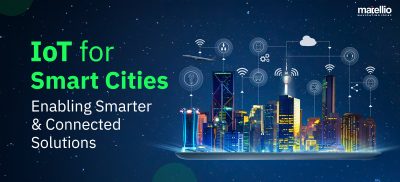
The Internet of Things has transformed our world, generating a constant flood of data from sensors and devices. IoT devices generate vast amounts of data, and to make sense of this data in real-time, organizations are turning to IoT stream analytics. This powerful technology allows businesses to process and analyze data as it is generated, enabling them to gain valuable insights and take immediate action.
In today’s blog, we will explore the concept of IoT stream analytics, its benefits, and how it is transforming industries. We will also delve into use cases and best practices for implementing IoT stream analytics in your organization. Let’s uncover the potential of IoT stream analytics platform to drive innovation and improve decision-making in the IoT era.

What is IoT Streaming Analytics?
IoT stream analytics is the process of continuously analyzing data streams from IoT devices in real-time. It involves the use of advanced analytics techniques to process data as it is generated, enabling organizations to uncover valuable insights, detect anomalies, and make informed decisions in real-time. By harnessing the power of stream analytics, organizations can optimize operations, enhance customer experiences, and drive innovation across various industries.
One of the key benefits of IoT stream analytics platform is its ability to provide real-time insights. Organizations can quickly detect and respond to critical events, such as equipment failures, security breaches, or customer issues before they escalate by analyzing data as it is generated. This proactive approach minimizes downtime and costs and enhances operational efficiency and customer satisfaction.
Another advantage of IoT stream analytics is its ability to handle large volumes of data. With the proliferation of IoT devices, organizations face massive amounts of data that traditional analytics tools need help processing. IoT stream analytics enables organizations to efficiently analyze this data in real-time, extracting valuable insights and patterns that would otherwise remain hidden.
Furthermore, IoT streaming analytics platform enables organizations to understand their operations and customers better. By analyzing data from IoT devices, organizations can identify trends, preferences, and behaviors, allowing them to tailor their products and services to meet customer needs more effectively. This customer-centric approach drives customer loyalty and opens up new opportunities for revenue growth and market expansion.
Also Read: Top IoT Trends for 2024
Want to Implement IoT Stream Analytics into Your Business?
Benefits of IoT Stream Analytics Platform
One of the key components of IoT is stream analytics, which involves analyzing data in real time as it is generated by connected devices. Let’s explore the benefits of IoT stream analytics and how it can transform businesses across industries:
Real-Time Insights: Perhaps the most significant advantage of IoT stream analytics is the ability to gain real-time insights into business operations. By analyzing data as it is generated, organizations can make faster, more informed decisions that can positively impact their bottom line.
Improved Operational Efficiency: IoT stream analytics can help organizations optimize their operations by identifying real-time inefficiencies and bottlenecks. For example, in manufacturing, stream analytics can help identify equipment failures before they occur, minimizing downtime and reducing maintenance costs.
Enhanced Customer Experience: By analyzing data from IoT devices, organizations can better understand customer behavior and preferences. This information can be used to personalize products and services, improve customer service, and enhance overall customer experience.
Predictive Maintenance: IoT stream analytics platform can enable predictive maintenance strategies by analyzing data from connected devices to identify patterns that indicate potential equipment failures. This proactive approach to maintenance can reduce downtime, extend equipment lifespan, and lower maintenance costs.
Cost Savings: IoT streaming analytics platform can help organizations identify cost-saving opportunities by optimizing resource utilization, reducing energy consumption, and minimizing waste. For example, stream analytics in the energy sector can help identify areas where energy is wasted and suggest ways to improve efficiency.
Data Security and Compliance: IoT stream analytics can help organizations improve data security by detecting real-time anomalies and potential security breaches. Additionally, stream analytics can help organizations comply with regulations and standards by ensuring that data is collected, stored, and processed securely and competently.
IoT stream analytics offers a wide range of benefits for businesses, including real-time insights, improved operational efficiency, enhanced customer experience, predictive maintenance, cost savings, and improved data security and compliance. By leveraging IoT consulting services to harness the power of IoT stream analytics, organizations can gain a competitive edge and drive business growth in the digital age.
Use Cases of IoT Streaming Analytics platform
IoT real time data streaming plays a crucial role in making sense of this data in real-time, providing valuable insights and enabling proactive decision-making. Let’s delve into some key use cases of IoT stream analytics across various industries:
Predictive Maintenance in Manufacturing
IoT sensors installed in machines collect data on performance, temperature, and other parameters. Stream analytics can analyze this data in real time to predict potential equipment failures, allowing for proactive maintenance and minimizing downtime.
Smart Energy Management
In the energy sector, IoT stream analytics can analyze data from smart meters to monitor energy consumption patterns. This data can be used to optimize energy usage, identify areas for efficiency improvements, and reduce costs.
Enhanced Healthcare Monitoring
IoT devices such as wearable health monitors can collect data on real-time patient vital signs. Stream analytics can analyze this data to provide early warnings of health issues, enabling healthcare providers to intervene promptly.
Also Read: IoT Healthcare Solutions
Real-Time Fleet Management
In the transportation industry, IoT stream analytics can analyze data from GPS trackers and sensors in vehicles to monitor routes, fuel consumption, and driver behavior. This data can be used to optimize routes, improve fuel efficiency, and ensure driver safety.
Retail Analytics
IoT streaming analytics platform can track customer behavior and preferences in-store. Stream analytics can analyze this data to provide personalized recommendations, optimize product placement, and improve the overall shopping experience.
Smart Agriculture
IoT stream analytics platform in agriculture can collect data on soil moisture, temperature, and crop health. Stream analytics can analyze this data to optimize irrigation schedules, detect crop diseases early, and improve yield.
Traffic Management
IoT real time data streaming can monitor traffic flow and congestion in urban areas. Stream analytics can analyze this data to optimize traffic signals, reroute traffic, and reduce congestion.
Environmental Monitoring
IoT streaming analytics platform can monitor environmental factors such as air quality, water quality, and noise levels. Stream analytics can analyze this data to detect pollution sources, monitor environmental conditions, and ensure compliance with regulations.
IoT stream analytics has a wide range of use cases across industries, enabling businesses to make real-time, data-driven decisions that drive efficiency, reduce costs, and improve customer satisfaction. As IoT stream analytics adoption continues to grow, the potential for digital transformation services to transform industries is limitless.
Optimize Your Business Operations with Advanced IoT Stream Analytics.
Challenges in IoT Stream Analytics Implementation
Implementing IoT stream analytics comes with its own set of challenges. Let’s explore some common challenges and solutions to ensure a successful implementation:
Data Volume and Velocity
Challenge: IoT devices generate massive amounts of data at high velocities, making it challenging to process and analyze in real time.
Solution: Implement a scalable stream processing system that can handle the volume and velocity of IoT data. Distributed computing frameworks like Apache Kafka or Apache Flink can be used to process data streams efficiently.
Data Quality and Reliability
Challenge: IoT data streams can be noisy and prone to errors, leading to inaccurate insights and decisions.
Solution: Use data cleansing techniques such as filtering, smoothing, and outlier detection to improve data quality. Implement data validation checks and error handling mechanisms to ensure reliability.
Latency and Real-Time Processing
Challenge: Achieving low latency in processing IoT data streams is crucial for real-time decision-making.
Solution: Optimize stream processing algorithms and use in-memory data processing techniques to reduce latency. Implement edge computing solutions to process data closer to the source, reducing latency.
Security and Privacy
Challenge: Securing IoT data streams and ensuring privacy is a major concern, given the sensitive nature of the data.
Solution: Implement end-to-end encryption, secure communication protocols, and access control mechanisms to protect IoT data. Use anonymization and data masking techniques to ensure privacy compliance.
Also Read: IoT Product Development: Use Cases and Development Process
Scalability and Resource Management
Challenge: Scaling IoT stream analytics to handle growing data volumes and device connections can strain resources and impact performance.
Solution: Use cloud-based IoT platforms that offer scalability and resource management features. Implement auto-scaling and load-balancing mechanisms to handle fluctuating workloads.
Integration and Compatibility
Challenge: Integrating IoT stream analytics with existing systems and ensuring compatibility with diverse IoT devices and protocols can be complex.
Solution: Use standardized IoT protocols such as MQTT or CoAP for device communication. Implement middleware solutions for seamless integration with existing systems.
Cost Management
Challenge: Implementing IoT stream analytics can incur significant costs, including hardware, software, and maintenance.
Solution: Optimize resource usage and implement cost-effective solutions, such as serverless computing and pay-as-you-go models. Conduct regular cost assessments to identify and address cost inefficiencies.
Implementing IoT stream analytics requires overcoming various data volume, quality, latency, security, scalability, and integration challenges. By employing the IoT development services, organizations can harness the power of IoT data streams to drive informed decisions and unlock new opportunities for innovation.
Get a Budget Estimate for Your Custom IoT Stream Analytics Implementation.
Best Practices of IoT Stream Analytics Implementation
Implementing IoT stream analytics effectively requires a strategic approach that encompasses both technical considerations and operational best practices. Let’s explore the key best practices for implementing IoT stream analytics:
Define Clear Objectives: Begin by defining clear objectives for your IoT stream analytics implementation. Identify the key business challenges you aim to address and the specific insights you seek to gain from IoT data.
Select the Right Tools and Technologies: Choose the appropriate stream analytics tools and technologies that align with your objectives and technical requirements. Consider factors such as scalability, real-time processing capabilities, and compatibility with your existing IoT infrastructure.
Data Preprocessing and Cleansing: Before performing analytics, ensure that your data is preprocessed and cleansed to remove any inconsistencies or errors. This step is crucial for ensuring the accuracy and reliability of your analytics results.
Real-Time Processing: Leverage the real-time processing capabilities of stream analytics to analyze data as it is generated. This enables you to detect real-time patterns, anomalies, and trends, allowing for timely decision-making and action.
Use of Machine Learning and AI: Incorporate machine learning and AI algorithms into your stream analytics process to enhance your analytics models’ accuracy and predictive capabilities. These technologies can help you uncover deeper insights from your IoT data.
Ensure Data Security and Privacy: Implement robust data security and privacy measures to protect sensitive IoT data. This includes encrypting data in transit and at rest, implementing access controls, and complying with relevant data protection regulations.
Continuous Monitoring and Optimization: Continuously monitor and optimize your stream analytics process to ensure its effectiveness and efficiency. This involve fine-tuning your analytics models, adjusting parameters, and incorporating feedback from users and stakeholders.
Integration with Business Processes: Integrate IoT stream analytics into your existing business processes to ensure that the insights generated are actionable and drive value for your organization. This involve automating decision-making processes or triggering alerts based on analytics results.
Hire IoT developers from a trusted IoT development company to follow these best practices and maximize the value of IoT stream analytics to unlock new opportunities for innovation and growth in your organization.
Conclusion
The real-time insights gleaned from IoT stream analytics platform are revolutionizing industries. As you’ve seen, continuous analysis unlocks a treasure trove of information, empowering you to make data-driven decisions, optimize operations, and anticipate future issues.
By harnessing the power of real-time data processing, organizations can unlock valuable insights, improve operational efficiency, and enhance decision-making processes. From predictive maintenance in manufacturing to personalized customer experiences in retail, the applications of IoT streaming analytics platform are vast and varied.
As we look to the future, the adoption of IoT stream analytics platform is expected to accelerate, driven by advancements in AI, machine learning, and edge computing. Organizations that embrace this technology stand to gain a competitive edge, enabling them to innovate faster, respond to market changes more effectively, and ultimately, deliver greater value to their customers.
Incorporating IoT analytics solutions into your organization’s strategy requires careful planning, investment in the right technologies, and a commitment to data-driven decision-making. By doing so, you can position your business for success in the digital age, leveraging IoT stream analytics to drive innovation, drive growth, and stay ahead of the curve.
FAQ
Why is IoT stream analytics important?
IoT stream analytics enables organizations to make real-time decisions, detect anomalies, predict outcomes, and optimize operations. It helps businesses gain a competitive edge by improving efficiency, reducing costs, and enhancing customer experiences.
How is IoT stream analytics different from traditional analytics?
IoT stream analytics differs from traditional analytics in that it processes data in real time, allowing for immediate insights and actions. Traditional analytics typically involves batch processing of historical data.
What are the popular IoT stream analytics platforms?
Popular IoT stream analytics platforms include Apache Kafka, Apache Flink, AWS IoT Analytics, Azure Stream Analytics, Google Cloud Dataflow, and IBM Watson IoT Platform.
How can I get started with IoT stream analytics?
To get started with IoT stream analytics, you can begin by defining your use case and objectives, selecting the right IoT devices and sensors, choosing a suitable analytics platform, and designing your data pipelines and analytics models.


